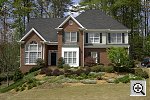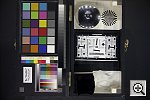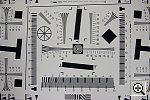|
Outdoor portrait: (890 k)
 The extreme tonal range of this image makes it a tough shot for many digicams, which is precisely why we set it up this way. (And deliberately didn't use fill flash.) The object is to hold highlight and shadow detail without producing a "flat" picture with muddy colors, and the PDC-2300 had a bit of a hard time. The shot at right has the exposure compensation boosted by 0.5EV, which lightened the midtones, giving reasonably good skin tones, but blew out the white shirt quite a bit. We shot this with the Auto white balance setting, feeling that it was a bit more natural-looking than the Daylight white balance. (900 k) Both were a bit yellow-green though. Other color is OK, but the blue flowers go quite a bit purple (a tough color, tends to go purplish. Shadow detail is very good. The table below shows an exposure series. The extreme tonal range of this image makes it a tough shot for many digicams, which is precisely why we set it up this way. (And deliberately didn't use fill flash.) The object is to hold highlight and shadow detail without producing a "flat" picture with muddy colors, and the PDC-2300 had a bit of a hard time. The shot at right has the exposure compensation boosted by 0.5EV, which lightened the midtones, giving reasonably good skin tones, but blew out the white shirt quite a bit. We shot this with the Auto white balance setting, feeling that it was a bit more natural-looking than the Daylight white balance. (900 k) Both were a bit yellow-green though. Other color is OK, but the blue flowers go quite a bit purple (a tough color, tends to go purplish. Shadow detail is very good. The table below shows an exposure series.
Exposure Compensation Settings:
0 EV
1/ 283
F/ 6.96
(878 k)
|
0.5 EV
1/ 216
F/ 6.96
(890 k)
|
1.0 EV
1/ 153
F/ 6.96
(915 k)
|
1.5 EV
1/ 112
F/ 6.96
(905 k)
|
|
|
| |
Closer portrait: (881 k)
 Very similar results to the longer portrait shot above. The 3x zoom helps prevent distorting the model's features, and detail is pretty good. Color overall has a bit of a yellow-green cast. The table below shows the results of a range of exposure settings from zero to +1.0 EV. Very similar results to the longer portrait shot above. The 3x zoom helps prevent distorting the model's features, and detail is pretty good. Color overall has a bit of a yellow-green cast. The table below shows the results of a range of exposure settings from zero to +1.0 EV.
Exposure Compensation Settings:
0 EV
1/ 203
F/ 6.96
(881 k)
|
0.5 EV
1/ 111
F/ 6.96
(912 k)
|
1.0 EV
1/ 98
F/ 6.96
(1034 k)
|
|
|
|
Indoor Portrait, Flash: (881 k)
The PDC-2300's flash has some significant problems. It produces a very bright "hot spot" in the middle of the frame, with severe falloff at the edges and corners. It's thus very difficult to get a good overall exposure with it. The exposure compensation adjustment does vary its intensity (a handy feature), but the uneven coverage makes it very hard to get the right exposure where you want it.
|
Flash, -0.5, 0, +0.5 EV intensity
|
 |
 |
 |
|
|
|
Indoor portrait, no flash: (1323 k)
|
Auto White Balance
|
 |
|
Incandescent White Balance
|
 |
This shot is always a very tough test of a camera's white balance capability, given the strong, yellowish color cast of the household incandescent bulbs used for the lighting, and the PDC-2300 did a surprisingly good job with it. Auto and Incandescent white balance settings produce very similar results, but we chose the auto setting for our exposure series below, thinking it to be a bit more natural. Both produced very magenta skin tones though, and strong purples in the blue flowers.
Exposure Compensation Settings:
|
|
|
House shot: (976 k)
|
Auto White Balance
|
 |
|
Daylight White Balance
|
 |
We shot this image with the automatic (976 k) and daylight (997 k) white balance settings, choosing the auto setting for our main selection. Neither settings was accurate, the auto was rather magenta, the daylight rather yellow. Resolution is also at the lower end of the range among two megapixel cameras we've tested.
|
|
| |
Far-Field Test (982 k)
 This image is shot at infinity to test far-field lens performance. NOTE that this image cannot be directly compared to the other "house" shot, which is a poster, shot in the studio. The rendering of detail in the poster will be very different than in this shot, and color values (and even the presence or absence of leaves on the trees!) will vary in this subject as the seasons progress. In general though, you can evaluate detail in the bricks, shingles and window detail, and in the tree branches against the sky. Compression artifacts are most likely to show in the trim along the edge of the roof, in the bricks, or in the relatively "flat" areas in the windows. This image is shot at infinity to test far-field lens performance. NOTE that this image cannot be directly compared to the other "house" shot, which is a poster, shot in the studio. The rendering of detail in the poster will be very different than in this shot, and color values (and even the presence or absence of leaves on the trees!) will vary in this subject as the seasons progress. In general though, you can evaluate detail in the bricks, shingles and window detail, and in the tree branches against the sky. Compression artifacts are most likely to show in the trim along the edge of the roof, in the bricks, or in the relatively "flat" areas in the windows.
This is our ultimate "resolution shot," given the infinite range of detail in a natural scene like this. Looking at this shot and the House Poster one above it, it's evident that detail isn't the PDC-2300's strong suit. There's a fair bit of information in the image, but it's very soft and mushy. The PDC-2300 also has a hard time coping with the strong highlight on the bay window in the front of the house, losing all detail there.
|
|
| |
Lens Zoom Range
We've received a number of requests from readers to take shots showing the lens focal length range of those cameras with zoom lenses. We unfortunately somehow missed taking the telephoto shot here, but it's a standard 3x zoom design, covering an equivalent range of about 35-105 mm.
 |
Wide Angle
Shutter: 1/ 68
Aperture: F6.69
(993 k)
|
|
(Oops, missed the tele shot here. It's a standard 3x lens though...)
|
|
|
|
| |
Musicians Poster (980 k)
 For this test, we shot with the automatic (980 k) and daylight (971 k) white balance settings, which produced similar results. The auto setting was the better of the two, but still none too good, with a greenish tinge overall, and a somewhat "muddy" appearance. For this test, we shot with the automatic (980 k) and daylight (971 k) white balance settings, which produced similar results. The auto setting was the better of the two, but still none too good, with a greenish tinge overall, and a somewhat "muddy" appearance.
|
|
|
Macro Shot (926 k)
 The PDC-2300 did very well in the macro category, capturing a minimum area of just 1.73 x 1.29 inches (33 x 44 millimeters). Resolution is high, with good detail visible throughout the image. The flash didn't work well this close in, as shown here,(981 k) but the PDC-2300's macro performance was one of the bright points in our evaluation of the camera. The PDC-2300 did very well in the macro category, capturing a minimum area of just 1.73 x 1.29 inches (33 x 44 millimeters). Resolution is high, with good detail visible throughout the image. The flash didn't work well this close in, as shown here,(981 k) but the PDC-2300's macro performance was one of the bright points in our evaluation of the camera.
|
|
|
"Davebox" Test Target (1022 k)
 We shot samples of this target using the automatic (1006 k) and daylight (1022 k) white balance. The two white balance options produced virtually identical results, the daylight being slightly more neutral. Color is ok, but a bit undersaturated, and the bright yellow swatch on the MacBeth chart is a bit greenish. Highlight detail is good, but the shadows are rather dense, with higher noise. Not the worst we've seen, but not the best either. We shot samples of this target using the automatic (1006 k) and daylight (1022 k) white balance. The two white balance options produced virtually identical results, the daylight being slightly more neutral. Color is ok, but a bit undersaturated, and the bright yellow swatch on the MacBeth chart is a bit greenish. Highlight detail is good, but the shadows are rather dense, with higher noise. Not the worst we've seen, but not the best either.
|
|
|
Low-Light Tests
The PDC-2300 didn't do too well in our low light tests, capturing a usable image only as low as 8 foot-candles (88 lux). This is about the level of a moderately dim residential interior, by comparison a city night scene under street lights is only 1 foot-candle. Thus, the PDC-2300 should be OK for indoor night time photos with the lights on, but probably can't handle outdoor night shots, even with bright street lighting.
8fc
88lux |
4fc
44lux |
2fc
22lux |

P23LL00
998.7 KB
|

P23LL01
565.3 KB
|

P23LL02
393.7 KB
|
|
|
|
Flash Range Test
In our testing, we found the PDC-2300's flash did fairly well, producing a usable image all the way out to 14 feet. Below is our flash range series, with distances from eight to 14 feet from the target.
| 8 feet |
9 feet |
10 feet |
11 feet |
12 feet |
13 feet |
14 feet |

P23FL08
976.6 KB
1/58 secs
F3.02
|

P23FL09
961.5 KB
1/45 secs
F3.02
|

P23FL10
948.5 KB
1/45 secs
F3.02
|

P23FL11
923.0 KB
1/45 secs
F3.02
|

P23FL12
902.8 KB
1/45 secs
F3.02
|

P23FL13
1,126.6 KB
1/45 secs
F3.02
|

P23FL14
1,027.1 KB
1/45 secs
F3.02
|
|
|
|
ISO-12233 (WG-18) Resolution Test (961 k)
 The PDC-2300 didn't do too badly on the resolution test. It cleanly resolved 550 lines per picture height, showed strong detail to 750 lines, and reached "extinction" at 900 lines. Overall, a bit lower than the best two megapixel cameras, but not too bad. In the distortion department, chromatic aberration was quite low, but barrel distortion at wide angle was high (1.0%), and pincushion at telephoto was also higher than average among other cameras we've tested (0.56%). The PDC-2300 didn't do too badly on the resolution test. It cleanly resolved 550 lines per picture height, showed strong detail to 750 lines, and reached "extinction" at 900 lines. Overall, a bit lower than the best two megapixel cameras, but not too bad. In the distortion department, chromatic aberration was quite low, but barrel distortion at wide angle was high (1.0%), and pincushion at telephoto was also higher than average among other cameras we've tested (0.56%).
|
|
|
Viewfinder Accuracy/Flash Uniformity
The PDC_2300's optical viewfinder is quite tight, at 83% frame coverage at wide angle, and 77% at telephoto. The LCD viewfinder does a bit better, at 92 and 91 percent respectively, but the LCD produces images shifted up slightly. (We're used to LCD viewfinder displays sometimes covering less than 100% of the final image area, but they generally are very well centered.)
As we observed in some of our other shots, the PDC-2300's flash coverage is very nonuniform, producing a strong "hot spot" in the middle of the frame.
|
|
|
|
|
|
|
|
|

Follow Imaging Resource: